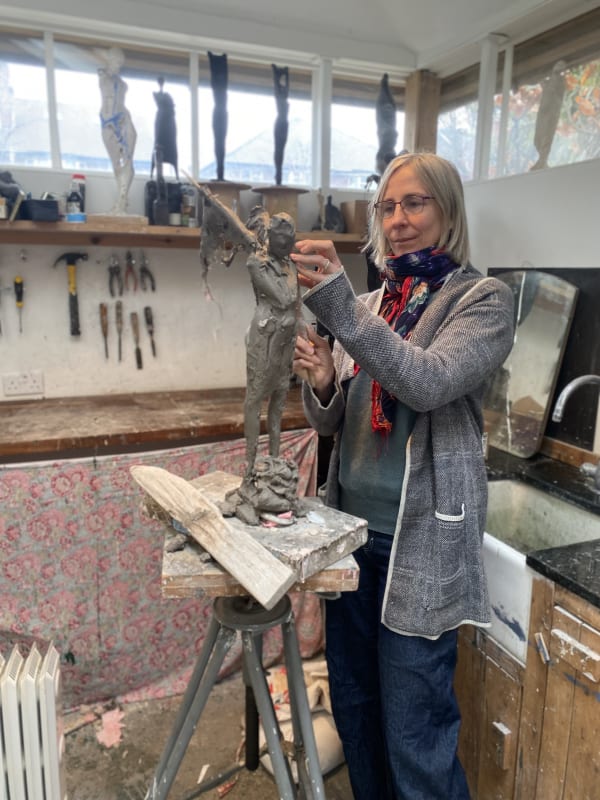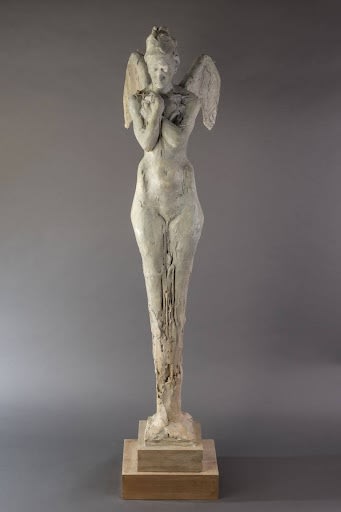I increasingly find myself dissatisfied with the idea that the essence of a person or place can be conveyed by a discreet, perfect physical form, so the surface of the sculpture shifts from rough to smooth and back again, and is disrupted by vertical lines and the shapes of found objects cast within the piece.
– Arabella Brooke, 2024
EASTWOOD FINE ART: You began your working life in an entirely different field, could you tell us how you came to become an artist?
ARABELLA BROOKE: I’m not sure I ever actually ‘became’ an artist. I come from a family of artists and writers, and even as a child, it wasn’t seen as unusual to want to bring paper and paints on holiday. The desire to look at something, to really ‘see’ it and then represent it, on paper or in 3D, has always been a part of my life.
So, while my academic and career path took me in a non-artistic direction, the ‘art’ side of things still flourished. I often found myself doodling in lectures or sketching colleagues in meetings, and I always attended art classes after work and on weekends. With hindsight, while I enjoyed the intellectual challenges of Oxford University and City life, I always felt like I was pretending to be someone else, and I am still happiest with dirty fingernails, wearing overalls, and actually making something.
EFA: Your figurative sculptures are imbued with an innate human sensitivity and presence. Tell us about your process, how do you begin?
AB: You are right that all of the sculptures are in essence figurative, and that they are always sort of ‘about’ what it means to be human. They start life as lines or scribbles in sketchbooks, often inspired by a glimpse of something I have seen, but back in the studio they are reworked and reimagined – first as drawings and then as small wax maquettes. These maquettes are so small that I cannot get distracted by the details of the figures, and have to concentrate more on lines of energy, space and form. I think not working directly from life gives the sculptures a universal, timeless quality which gives them an intense emotional resonance. I am less worried about how accurate the figures are and more interested in the ideas they communicate.
EFA: Alongside your sculpture, you also draw, often depicting figures set within serene landscapes. How do these two mediums relate to one another in your practice?
AB: I have always drawn as part of my sculpture practice, but I began selling drawings in lockdown, when I was home-schooling three children, and unable to work properly in the studio. It was a life-saver for me, being able to escape into these large, imaginary landscapes on paper, across which mythical lone figures moved towards distant homes or cities.
I enjoy the immediacy of drawing - sculpture is a much slower and more deliberate process - but I am always and unfailingly totally in awe of the sheer physical presence of sculpture. Unlike a painting, a sculpture occupies its own space in the garden or a room and shows infinite different versions of itself depending on how the light hits it during the day. Not only that but the sculpture much more than a painting, changes depending on your distance from it. You experience a sculpture with your entire body, just by moving around it. It is a completely visceral experience.
EFA: Your work is primarily process-led, are there any outside sources you draw on for inspiration? What have you been looking at or thinking about recently?
AB: Like Hepworth and Moore, my work is inspired by nature and natural forms. I am interested by the way surfaces get worn down by weather and time, some worn smooth, others rough, and how lichen and rust blur some of the sharper edges as objects age. I am searching for some of this unpredictable elemental quality in my newer work – the most recent series of angel sculptures have seen me working rose stems and manmade objects like screws and nails into the clay as I go.
EFA: For SPOTLIGHT, you are showing two new sculptures – titled Hedgerow Angel and This fragile thing we hold, both 2024 – could you tell us more about them?
AB: Hedgerow Angel is the newest bronze sculpture, the first in a new series of angels conceived after we moved to rural Dorset in 2023. I had recently visited Laurence Edwards’ Yoxman of Suffolk, and it had a tremendous impact on me. It got me thinking about the idea of the spirit of a place, how different geographies have their own specific vibration or ‘feel’. The challenge seemed to be whether you could represent this spirit in sculptural form, like Antony Gormley’s Angel of the North, and so the idea of a series of West Country angels took shape.
I took as my inspiration the time-worn stone figures found in local Dorset churchyards, where the edges and details have softened and changed by the passage of time and weather, which leaves one surface smooth and undulating, and others so rough they take the skin off your hand as you brush over it. I increasingly find myself dissatisfied with the idea that the essence of a person or place can be conveyed by a discreet, perfect physical form, so the surface of the sculpture shifts from rough to smooth and back again, and is disrupted by vertical lines and the shapes of found objects cast within the piece.
This fragile thing we hold began as a study of a single figure struggling under the weight of the world, but it felt unbalanced and incomplete. So I added the second figure to share the burden, and suddenly it made more sense. At one level, the ‘fragile thing’ in the title refers to the future of the planet, an overwhelming burden, but it also points to the genuinely hopeful possibilities offered by global collaboration and cooperation. Perhaps more importantly, it relates to the lived daily experience of every person, day-to-day. Isolated, we may feel like we carry the weight of the world on our shoulders but realising we share the burden means a new perspective and a genuine lessening of pressure.



